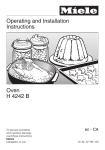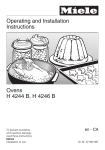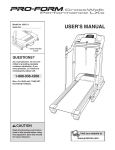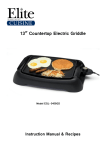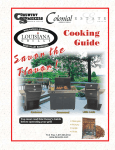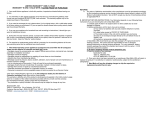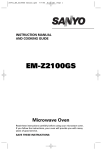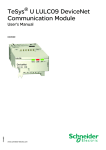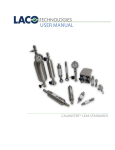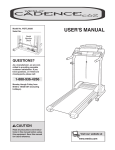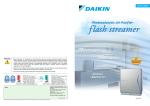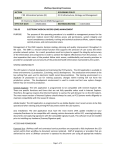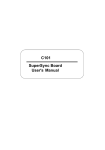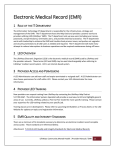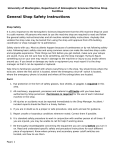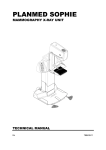Download OWNERS MANUAL - Blue Ridge Mountain Cookery
Transcript
Blue Ridge Mountain Cookery, Inc. PO Box 70 Waynesboro, PA 17268 Ph: (717) 762-1211 Fax: (717) 762-1966 Email: [email protected] Web: www.classiccookers.com OWNERS MANUAL ClassicC lassicCooker 1000 TowTow-Behind Congratulations on purchasing a Blue Ridge Mountain Cookery, Inc. gas grill. Made primarily of stainless steel, with proper care, it will last you for years of professional cooking. This manual will outline some things you should know about your new purchase, and will also help you troubleshoot problems you may have. Thank you for your business- We appreciate it! Series 1000 Trailer Mounted Mounted Grill With the exception of the trailer components, virtually every part of the BRMC Series 1000 Cooker is made of stainless steel. The axles have a rating of 2000 lb., while the dry weight of the Cooker is 670 lb. The burners are rated at 30,000 BTUs each, and are individually controlled by valves affixed directly to the gas orifices. The cooking surface is approximately 24.5” x 60”, and the grate is ¼” stainless steel rod. A total of three burners generate the heat required to cook for your clients. A set of rolled stainless steel lids equipped with cool grip handles covers the cooking surface. The lid moves on a pivot point, so there are no hinges or lid stays to operate. Each trailer-mounted barbecue comes equipped with a light package and license plate holder, and is street legal once it has been licensed by your state DMV. The trailer unit is not equipped with its own set of brakes. Please ensure that you allow sufficient room for safe stopping of the tow vehicle and barbeque combined. VIN Number Every auto, truck, bus, and trailer manufacturer around the world must identify each vehicle they manufacture with a Vehicle Identification Number that is specific to that vehicle. BRMC mobile gas cookers are no different. You will notice that there is a plate mounted on the tongue of each trailer that lists the VIN for that unit. As well, you are supplied with a Certificate of Origin from BRMC that also has the VIN prominently displayed for licensing requirements. 1 General Precautions for Your Safety 1) Propane is a flammable gas that is under pressure. Leaking propane may cause a fire or explosion if ignited. 2) An odor has been added to propane to make the detection of a leak easier. If you smell, hear or see leaking LP gas, immediately call the fire department. Do not attempt to make repairs. WARNING: ARNING : Under some some circumstances, propane may lose the distinctive odor that was added. Keep the service valve closed and plugged or capped when the cylinder is not hooked up, including empty cylinders. Other strong odors may mask or hide the odor of propane. Colds, allergies, allerg ies, sinus congestion, and the use of tobacco, alcohol or drugs may impair your ability to smell. 3) Propane is heavier than air, and may initially concentrate in low places prior to dissipating. 4) Contact with the liquid contents of the cylinder will cause freeze burns to the skin. Some Do’s and Don’ts 1) When transporting the cylinder or when it is otherwise not connected for use, keep it secure in an upright position with the cylinder valve turned off and tightly plugged or capped (per the cylinder manufacturers instructions). 2) Take your cylinder only to a reputable supplier for filling, repairs or disposal of unused propane. 3) Caution your LP gas supplier to: • Be certain the cylinder is purged of trapped air prior to first filling; • Be certain not to fill the cylinder beyond 80% capacity; • Be certain the cylinder requalification date is checked 4) If you replace your cylinder at an exchange service, be sure the new cylinder has the same connection as the one you had previously. • 5) DO NOT allow children to tamper or play with the cylinder or grill. • 6) DO NOT use, store or transport the cylinder where it would be exposed to high temperatures. Do not use or store the cylinder in a house, building, garage or enclosed area. The pressure relief valve may open, allowing a large volume of flammable gas to escape. 7) CAUTION: DO NOT depressurize the cylinder before taking it to be refilled. 2 Using Your BRMC Cooker Safely Blue Ridge Mountain Cookery recommends that you clean your grill after every use. A liberal application of a residential or commercial grade oven cleaner (such as Easy Off) should be sprayed on the grill surface and interior tub. Rinse thoroughly with a high-pressure water hose. It is important to remember to fire up your BRMC Cooker after cleaning cl eaning so you eliminate water that has collected in the burners. The cylinder valve outlet must be plugged whenever the cylinder is not connected to the grill or being transported, unless it is a quick connect type of cylinder valve. The plug is an additional safety measure designed to hold the propane on the tank if the handwheel is inadvertently opened. Quick connect cylinder valves have an extra check valve so they do not require a plug. Protective caps are available for quick connect valves, and should be used to help keep dirt and other contaminants from the outlet. Use your propane cylinder(s) in the position they were designed for. The Classic Cooker Series 4000 is designed for two upright gas cylinders. The Classic Cooker Series 1000, however, is designed to use a single horizontal tank. DO NOT use BRMC Cookers indoors. When propane burns, it uses oxygen. If the grill is used indoors, this can result in asphyxiation or carbon monoxide poisoning. DO NOT use BRMC Cookers close to the side of a house or structure, and never use under any surface that will burn, such as a carport, tent or awning. If there is a fire due to a propane leak, or a flare up from grilling, the fire can be spread to combustible material close by or above. DO NOT store a spare cylinder under or near the grill or in the garage, due to exposure to high temperature. Connecting the Cylinder to the Grill When connecting the regulator to the cylinder valve, be sure the pressure relief valve (usually located opposite the connection to the regulator) is directed away from the front of the grill. If the relief valve should open, the propane will be directed to an area that will do the least harm. Ensure that all hoses, fittings and the regulator are properly protected from heat and accidental damage. Hoses can be burned or chaffed if routed improperly. Hoses are secured at the BRMC factory with tie down plastic straps to prevent 3 chaffing. Be sure that all burner control valves on the grill are turned off. After connection is complete, check for leaks. Thread the connector attached to the inlet side of the regulator into the service valve on the cylinder. Remember that since the connection has a leftleft-handed thread, you must turn it counter clockwise to tighten. Tighten the connection with a small adjustable or open-ended wrench. Where allowed by local regulations, some grill cylinder valves may be equipped with a device, which allows you to connect without tools. There are two such types of valves. One type uses a spring-loaded sleeve on the valve, and is known as a quick disconnect. When the sleeve is pulled back, the regulator probe can be inserted. Release the sleeve to complete the connection. The other type is known as a quick connect valve. This one has large threads on the outside of the valve. A large plastic nut on the regulator screws onto the valve threads. Checking For Leaks Before lighting your BRMC Cooker, check all connections for tightness using a solution of 1/2 liquid soap and 1/2 water. DO NOT use matches or lighters to check for leaks. DO NOT smoke while performing leak tests. With all the valves on the grill turned off, slowly open the cylinder valve by turning the handle counterclockwise. Apply the solution to the connections being tested (hose connections, service valve, base and stem of the service valve, and regulator). If bubbles appear, become larger in size or increase in number at any connection, a leak exists. This must be corrected before the grill can be used. Turn the cylinder service valve handle completely off by turning clockwise. Disconnect the regulator connector from the cylinder, and call your local propane gas supplier for further instructions. 4 Lighting Your BRMC Grill WARNING: WARNING : Failure to open lid while igniting the barbeque, or not not waiting five minutes to allow the gas to clear if the barbeque does not light, may result in an explosive flame up which can cause serious bodily injury or death. The Series 4000, Series 3000 and the Series 1000 BRMC Grills are equipped with a 15” long butane lighter for ease of lighting your barbecue. If there are no leaks at any of the connections, proceed as follows: Series 1000 • • • • Turn cylinder handle counterclockwise to open valve on the tank. Open lid; remove the stainless steel drip pan (if equipped) that covers the entire cooking area. Turn gas control valve underneath countertop on halfway, then place the ignited end of the butane lighter (supplied) through the hole next to the gas control valve. The resulting flame will ignite the propane, and your burner will be fired. Once the burner has ignited, you may now set your gas control knob to the desired flame setting. Follow the same directions for the number of burners you wish to light. In the event the burner does not ignite within five (5) seconds, turn the control off, and tune to the troubleshooting section of this manual. • Do Not use the stainless steel drip pan if you are grilling food. This is to be used only if you are cooking large amounts of fatty meat, such as a pig. Optimum heat will be reduced if you use the drip pan when grilling. Disconnecting the Cylinder from the BRMC Grill 1. Before disconnecting the cylinder, close the cylinder valve. Turn the handwheel clockwise to close. 2. Disconnect the regulator from the cylinder valve. If the valve is a POL style, disconnect the POL connection from the cylinder valve by turning the POL connection clockwise. Insert a POL plug into the valve outlet. Keep the service valve closed and plugged when the cylinder is not connected for use. If a valve is a quick disconnect style, retract the sleeve to disconnect. If a valve is a quick connect style, unscrew the regulator nut to disconnect. 5 Replacing an Empty Cylinder If the cylinder has not been filled before, the propane supplier must purge the cylinder with propane vapor to remove the air. Also, if the cylinder valve has been left open, air may have entered the cylinder, and the supplier will have to purge the cylinder before filling it. Before filling the cylinder, the propane supplier will examine the cylinder to make sure it is suitable for filling. If it is an older cylinder, they may mark the collar to indicate that the cylinder has been requalified. They will check the cylinder and valve for leaks. There are limits on how much propane can be put into a cylinder. The cylinders that come with BRMC barbeques hold approximately 40 lbs. This leaves some room for the liquid to expand. DO NOT ask the propane supplier to overfill the cylinder. The propane supplier cannot return the cylinder to use unless the cylinder valve has a plug in the outlet. Valves with quick connect outlets do not need a plug. They should, however, have a dust cap. The propane supplier cannot return the cylinder to you unless it has a proper warning label. The warning label will have information on the potential hazards of propane. Each consumer should read the warning label. Transporting the Cylinder Secure the cylinder in an upright position, unless you are using a cylinder that is designed for horizontal use, such as one for the Series 1000 Classic cooker. Put a cap or plug in the cylinder valve outlet, unless it is quick connect type of cylinder valve. Always make sure that the valve hand wheel is fully closed. DO NOT transport more than four 20 lb. cylinders at any time in an enclosed vehicle. Take the cylinder(s) directly to your BRMC Barbeque after they have been filled. DO NOT leave cylinders in the trunk or in direct sunlight. The inside of the vehicle can become hot, which will raise the pressure of the propane. If the pressure becomes high enough, the relief valve will vent flammable gas. Storing the Cylinder 6 DO NOT store propane cylinders indoors (such as a garage) or near sources of heat. DO NOT store spare cylinders under the BRMC Barbeque. There is a relief valve on the cylinder. If the pressure inside the cylinder gets too high, the relief valve will open and discharge propane. Repairing the Cylinder or Disposing of Unused Propane DO NOT use if the cylinder shows signs of tampering or abuse. DO NOT attempt any repairs to the cylinder or cylinder valve. Take the cylinder to your propane supplier for any repairs. DO NOT dispose of unused propane by opening the cylinder valve and venting vapor to the atmosphere. Take the cylinder to your propane supplier. In Summary, Some important tips DO NOT ....Use the propane cylinder if it shows signs of dents, gouges, rust, bulges, fire damage, corrosion, leakage, or other forms of external damage. Consult your local propane supplier for further instructions. ....Attempt to repair cylinder valves, regulator, or hose connections. All repair work should be done by your local propane supplier. ....Attempt to light the unit unless the lid(s) are open and the stainless steel drip pan has been removed. .... Allow anyone (including children) to tamper with components of the grill or the propane gas cylinder. .... Allow anyone to conduct any activities around the BRMC when the barbeque is in use, or following its use. The grill body, lids and other parts of the barbeque will remain hot for some time following its use. .... Use the BRMC barbeque directly adjacent to the side of a structure, and never under any surface such as a carport, porch or garage. 7 .... Store cylinders inside enclosed structures or in areas where the cylinder would be exposed to excessive heat. This includes storing a spare cylinder close to a grill. .... Dispose of unused propane by opening the valve and venting to the atmosphere. Take the cylinder to your propane supplier for disposal. DO ...enjoy the fun and convenience of cooking on your new Blue Ridge Mountain Gas Barbeque. You will find the craftsmanship to be second to none, and with the use of propane, there is no waste of time and energy. As a professional chef, caterer, rental store owner, or serious home Grillophile, you deserve to work with the superior components to compliment your grilling efforts. Thank you for purchasing a Blue Ridge Mountain Cookery Barbeque. We appreciate it. Troubleshooting 1. The BRMC Cooker does not light. • On the Series 4000 Cooker, make sure that all of the valves are open to the • • • • side you wish to light, and the handwheel on the tank is open. On the Series 1000 Cooker, make sure all valves are open from the tank handwheel. Make sure there is fuel in the tank Follow lighting procedures outlined in manual by inserting a long barbeque match or flexible tip butane lighter that is lit; place near small openings on burner ring, and open gas control valve. Ensure that the air chamber is fully open on each burner. 2. Yellow or orange flame is visible, rather than a blue flame. • Ensure that the air chamber behind the gas control valve is fully open and tightened in this position. Due to travel, this shutter may partially or fully close in transit. • Make sure that the burners are clean and free of grease. 8 ClassicCooker Grills & Roasters PO Box 70 ● Waynesboro, PA 17268 ● Phone 800-COOKERS 717-762-1211 ● Fax 717-762-1966 EMail: [email protected] ● Website: www.classiccookers.com How to Use Your Classic Cooker The following pages are meant only as a basic, practical guide to grilling, barbecuing, smoking, and properly utilizing the options on the ClassicCooker Series 1000, 3000, 4000, and Patio Grills. The more you use your grill, the more familiar you will become with how it cooks, what types of temperatures to expect, and how to utilize your unit to best fit your cuisine. There will be a brief overview of the basic parts of the grill and then a breakdown on how to use your cooker to grill, barbecue, smoke, or steam food. I will also explain how to use the various options that you may have purchased with your unit. The Cooking Parts – there are (7) important pieces of your Classic Cooker unit that affect how it cooks and allow it to perform as well as it does. Each piece serves a unique function and it is important to know what they do and how they work. I will start from the bottom and work up. 1. Firebox – This is the stainless steel box insert that houses the burners, grates, radiant, and roasting pan. It is the basic inside shell that allows for easy cleaning and provides an inside barrier against heat. On the bottom of the firebox there are four “tented” ventilation holes that feed oxygen to the burners and allow greater heat output. The three stainless steel burner mounts are also located in the bottom of the grill and allow for easy installation and removal of the burners. There is also a grease drain cut into the rear of the firebox to allow grease to flow out of the unit when using the roasting pan or to allow food particles and water to exit the unit while cleaning. 2. Burners – Each BRMC firebox contains three, individually controlled, cast iron, loop burners. Each burner is attached to the mounting bracket via two locking pins. To remove the burner, simply remove the pins, slightly lift up on the burner, and pull the burner out. Each loop burner uses 30,000 BTU’s and will create enough heat to raise the surface temperature of the cooker to 650° F and can hold a continuous temperature as low as 125° F. 3. Radiant – Attached at six points around the inside of the firebox with post mounts and removable pins, the radiant performs several vital functions. Constructed of ¼” plate steel, the radiant is one of the few internal parts not constructed of stainless steel and will, over time, develop rust. Because stainless steel conducts heat, but does not hold heat, plate steel is used instead. When the dome of the unit is lifted, approximately 150° to 175° F is lost from the cooking area. Because the radiant holds heat very well, the unit excels at quick heat recovery and will come back up to temperature in less than two minutes after the dome is closed again. The 9 radiant also protects the burners from grease and food particles and reduces flare-ups by searing grease onto the surface. Simply flip the radiant each time you use the cooker to burn the grease off the bottom and provide a clean surface on the top. Last, but not least, the radiant provides an even cooking temperature across the surface of the grill. For maximum heat coverage, the Cooker should always be placed on as level a surface as possible. 4. Grease Funnel – Although small, the grease funnel in the Cooker provides a vital safety role in the overall performance of your unit. Constructed of stainless steel and mounted on the end of the heat radiant, toward the rear of the firebox, the grease funnel guides grease from the cooking surface of the unit to the opening on the bottom of the unit. When roasting foods with the roasting pan in place, the grease funnel allows grease to easily flow away from the flames and out of the grill, greatly reducing the opportunity for grease fires to develop in the firebox. It is very important that the grease funnel stays in place at all times during the cooking process and that excess grease buildup that may occur in the funnel is cleaned out on a regular basis. 5. Roasting Pan – The roasting pan is the most important part of your unit when you are slow-cooking, smoking, or roasting meats on your Cooker. THE ONLY TIME THE ROASTING PAN IS USED IS WHEN PERFORMING THESE COOKING TECHNIQUES; FOR DIRECT GRILLING, THE ROASTING PAN IS REMOVED FROM THE FIREBOX. When being utilized, the pan rests on the ledge below the cooking grates with the drain spout toward the rear of the Cooker, over the grease funnel. Never try to cook food directly on the roasting pan. The roasting pan accomplishes three important tasks: a. The roasting pan collects grease from fatty foods such as pork shoulders or ribs and prevents the grease from reaching the radiant and the burners. Notice that the pan slants from one end to the other, toward a spout mounted in the deep end of the pan. This spout must always be placed above the grease funnel to allow the proper flow of grease out of the unit. b. The roasting pan also is beveled in the center and features holes cut along both sides approximately ¾ of the length of the pan. This special configuration forces the heat in the firebox to come up and around the edges of the pan and along with the curved shape of the domes, creates convection inside the cooking area. The convection movement of the heat allows food to be roasted evenly on all 10 sides, without having to use a rotisserie or turning the meat. This allows you to cook a brisket, steamship rounds, turkeys, or even whole hog (refer to recipe for “Pig Roast on the Cooker”) on the unit without a rotisserie! c. The roasting pan also prevents the cooking area inside the domes from reaching temperatures in excess of 350° F. This allows for the food on the cooking surface to roast slowly and maintain moisture. Do not try to grill over the roasting pan, as the grill surface will not reach optimal grilling temperature, and although food will cook, it will take much longer than necessary. 6. Cooking Grates / Roller Grates – Unless equipped with optional equipment, such as the steam table, griddle plate, or one of our various rotisseries, all the food prepared on the Classic Cooker is cooked on the cooking grates, also referred to as roller grates. Steaks, burgers, hot dogs, etc. are cooked on the roller grates, directly over the radiant. Turkeys, pork shoulders, hogs, ribs, etc. are roasted on the roller grates, directly over the roasting pan. The roller grates on your cooker are constructed of solid stainless steel, free rolling rods which provide a great cooking surface allowing for searing of grilled foods, while providing an easy-to-clean and sanitary surface that will never rust. Notice that the rods are “loosely” fitted into the “rod ends”; this allows the rods to expand and contract as they heat up or cool down, without warping or twisting. For optimal performance, spray a non-stick coating, or apply olive oil to the rods before placing food on the grill. Domes – commonly referred to as domes or lids, these are the solid stainless steel curved pieces over the top of each firebox or cooking area. Split into two pieces for venting and ease of access to the cooking surface, the shape also assists in creating convection inside the unit when the domes are down or closed. The primary dome is the taller piece and is located on the front of the unit, along with the burner controls and the drop down shelf. The secondary side is fixed on CC3000 and CC4000 8. units, but can be opened on the Patio and CC1000 units. 7. 11 ClassicCooker Grills & Roasters PO Box 70 ● Waynesboro, PA 17268 ● Phone 800-COOKERS 717-762-1211 ● Fax 717-762-1966 EMail: [email protected] ● Website: www.classiccookers.com Direct Grilling on the Classic Cooker (Steaks, Hot Dogs, Sausages, Chicken, Kebobs, Etc.) Before tackling “grilling”, let me first define some terms and give a brief overview of the difference between grilling and barbecuing. For everyone in North Carolina and Texas, skip this part and move directly to “Grilling”, everyone else please read this. The Difference between Grilling and Barbecue This is a question that is asked by many, but not widely known or understood. A lot of the confusion lies in the fact that people often use the same piece of equipment for grilling as they do for barbecue. The two are however antithetical to one another. Grilling Grilling is a high heat cooking method. Food is cooked directly over the coals and is normally ready in a matter of minutes. Grilling temperatures are usually in excess of 500 degrees Fahrenheit, and food is cooked close to the heat source. The high heat chars the surface of the food, seals in the juices and creates a smoky caramelized crust. Grilling is the oldest, most widespread and most forgiving method of cooking. Rich and poor alike practice it on six continents in restaurants, street stalls, and backyards. Barbecue Barbecuing by contrast lies at the opposite end of the spectrum from grilling. It is a long, slow, in-direct, low-heat method that utilizes very low temperatures, smoke, and time to cook the food. Barbecue temperatures are usually between 200 and 300 degrees Fahrenheit. This low heat generates smoke, and this smoke gives barbecue its characteristic flavor. The heat source is often separated from the cooking chamber, which contains the actual food. This method of cooking is ideally suited to large pieces of meat such as whole pigs. It is also perfect for cuts with lots of tough connective tissue, like brisket and spareribs. In fact barbecue was traditionally associated with the poorer echelons of society, who were unable to afford the more expensive cuts of meat. Indirect Grilling 12 More recently a hybrid method of cooking, Indirect Grilling, has become very popular. This method bridges the gap between barbecue and grilling. As with barbecuing the food is not cooked directly over coals. But the actual cooking takes place in the same chamber as the heat source, and temperatures usually range between 350 and 400 degrees Fahrenheit. Wood chips or chunks are often placed on the heat source to generate smoke for flavor. Indirect grilling effectively transforms your barbecue grill into an outdoor oven, which is perfect for cooking larger cuts of meat such as prime rib and turkey. . Indirect grilling gives you the best of both grilling and barbecuing - the charcoal flavor from grilling and the tenderness and smoky flavor from barbecue. Whereas the flavor of true barbecue is hard to beat, the trade-off is that it takes a lot longer than grilling or indirect grilling. We actually use all three of the above cooking methods and each method can be utilized on the Classic Cooker Patio, 1000, 3000, and 4000 unit. Each method has its own merits Direct Grilling Grilling directly on the roller grates of your ClassicCooker unit is as easy as it sounds. There is one common mistake made when first time users try and cook burgers, dogs, chicken, steaks, or whatever on the grill. Remember: Before grilling on the Cooker, remove the roller grates and remove the roasting pan. With the roasting pan in place, the grill surface will not achieve temperatures above 350° F and it will take forever to grill your foods. Remove the roasting pan to achieve grill temperatures in excess of 600° F. Grilling is done directly over the heat radiant. Once you have removed the roasting pan, set it off to the side and place the roller grates back into the grill. Season the grates using a non-stick spray or a light coating of olive oil to ensure that your food does not stick. Check to make sure all of the burners are in the “OFF” position (horizontal), and open BOTH propane tanks. It is important that both tanks are open (especially on the CC1000 and Patio unit) to ensure that the regulator does not “freeze up”, particularly on very warm days, and to keep the tanks at an even level and keep the pressure at a steady rate. Following the instructions in the manual, light each burner individually, and allow the grill to “warm up” for 10 to 15 minutes to reach the desired temperature. Place food on the grill and grill to your heart’s content, adjusting the burners accordingly to meet your temperature needs. Grease will drip onto the heat radiant and sear on the metal, creating smoke that will filter back into the food and give your food an additional flavor boost. An abundance of grease will cause minor flare-ups, so make sure to not walk away from the grill while it is in use. It is also recommended that the heat radiant be “flipped” each time you grill on the Cooker. Simply remove the six clips that hold the radiant in place, 13 lift the radiant out, and turn it over. This will allow the grease to burn off the bottom of the radiant and provide a relatively clean, grease free surface to grill over each time. When you are finished grilling, turn off the gas at the bottles and let the flames go out in the burners. After the flames have died, turn the burners off (horizontal position). By turning off the gas before turning off the burners, any gas trapped in the gas lines will be burned off. ROASTING ON THE COOKER What to Roast All ClassicCooker Tow-Behind models and the ClassicCooker Patio Cooker come standard as both a grill and a slow roaster. We have roasted – and have had customers roast – whole hog (up to 165lbs.), turkeys, pork shoulders, hams, ribs, pit beef, lamb, and venison on our units – right on the grates, without a rotisserie! Getting Ready Open the dome and remove the two cooking grates. Remove the roasting pan and examine the inside of the cooker to make sure that it is clean and there is not any grease build-up. If you want to add smoke to your roasting, now is the time to get the cooker ready. Place chunks of wood ( note chunks, not chips) that have been soaking at least six hours directly onto the radiant, toward the front of the cooker. Apple and cherry are my favorite, but mesquite and hickory work well too. Just make sure to use fairly large pieces and that they are soaked through to prevent flame-ups. Depending on the size of the wood, you will get smoke from 3-6 hours. Start the cooker. Make sure all control knobs are in the “off” or horizontal position and turn on both LP tanks. Turning on both tanks will prevent freeze up and will allow you to get 10-12 hours of continuous cooking time. Also this will deplete both tanks simultaneously, so you don’t use one tank and then find that the other tank is empty. One at a time, turn on a burner and then light the burner using the flex lighter provided with the unit. Burners will not light off each other and have to be lit individually. Continue until all burners are lit. Over the Fire Set the roasting pan in place. The roasting pan is the 5’ stainless steel, beveled pan that came with the cooker. Make sure to position the roasting pan so that the opening on the end sits above the funnel that leads to the opening in the bottom of the grill (hole should be toward the rear of the grill). If it is not in place properly, the grease from your food will go into the bottom of the grill and there is a real 14 chance for fire. When the pan is in the proper position, no problem. The grease will flow onto the roasting pan down to the opening, down the funnel and out underneath the grill. Just slide a bucket or metal pan under the hole, so the grease won’t hit the ground. You will get about ½ gallon of grease from a 60lbs. pig – the larger the pig, the more grease you get. Also, make sure the grill is as level as you can get it. It is OK if the front of the grill is a tiny (and I mean tiny) bit up to help the grease flow towards the hole, but try to keep it level. The roasting pan is designed to create a convection movement with the heat inside the domes. Notice the pan is beveled to catch the grease and funnel it to the opening on the one end. Also notice that there are holes cut each side about ¾ of the length of the pan. Set the head of the pig at the end toward the front of the grill, where there are no holes, to prevent burning. Replace the cooking grates over the top of the roasting pan. Be careful, the cooker is on. Prepare your meat with whatever rub you desire – DO NOT WRAP THE COOKING GRATES IN FOIL OR THE MEAT IN FOIL, THAT WILL TRAP THE GREASE AND CREATE A SERIOUS FIRE POSSIBILITY. Lay the meat across the grates. . Check it every ½ hour or so to make sure the grease is flowing properly, etc. Have your thermostat ready to check temps. Also remember, you have ½ hour to 45 minutes after you take the meat off the grill to let it “set up” before you carve it Close dome. You might be eager to shorten the cooking time as much as possible. (Not sure why you would want to cut into beer-drinking time) but, BE WARNED, it is important that the meat does not roast too rapidly at the beginning. This will result in the outside becoming hard, preventing the heat from penetrating to the interior. So, start off slowly and gradually turn the heat up. The most difficult part of pulling off a good slow cooked roast is getting the outside of the meat golden brown and nicely caramelized and at the same time getting the meat inside cooked all the way through to the bone. For the majority of the cooking duration you will want your fire to be at about 325° F (The fire is at 325° F if you can hold your hand at the cooking level for at least 8, but no more than 12 seconds). When is the Meat Ready? In roasting like most other forms of cooking, the length of time the meat must cook depends on a number of factors: the size of the carcass; the heat of the fire; prevailing wind and weather conditions; and not least, the ability of the chef to control fire and beast. . Figure a ½ hour for every 9 pounds – 100lbs. pig = 5 - 6 hours. When your food has been cooking for the suggested amount of time, insert an instant read meat thermometer into the thickest part of the cut. Pork should register about 170° F to be done. If you don’t have a thermometer, pierce the thickest part of the meat with a skewer or knife. The juices should run clear, without any trace of pink. When you are finished roasting, turn off the gas at the bottles and let the flames go out in the burners. After the flames have died, turn the burners off (horizontal position). By turning off the gas before turning off the burners, any gas trapped in the gas lines will be burned off. 15 PIG ROAST ON THE GRILL Whole Pig (average 100-120 lbs. cleaned) 1 lb. Black pepper 25 garlic cloves Salt 5 lbs. Stuffing Meat Thermometer Needle and cooking string Vegetable Oil Order pig from butcher cleaned and in a “Tucked” or “Sitting” position. Preparing the Carcass Calculate the amount of salt and pepper required for seasoning the whole carcass by allowing 1 teaspoon of salt and pinch of freshly ground black pepper, per pound. Mix the salt and pepper together and rub a quarter of the mixture on the inside of the stomach cavity, keeping the rest to season the beast towards the end of the cooking time. Cut slits in skin and insert garlic cloves. If you plan on closing the stomach cavity for cooking, as opposed to roasting it openstyle, make up the following mixture and rub this into the cavity of a lamb or pig before closing it. 3 tablespoons 3 tablespoons 3 tablespoons 6 cloves 3 tablespoons 2 teaspoons lemon juice orange juice cooking oil garlic, coarsely chopped coarse salt black pepper Or use one of the rub recipes attached for Zip Zap rub or Zap Zip rub. They work great too. Stuffing Ideas If you decide to stuff your beast – highly recommended - the type of stuffing you use, will depend on what you are cooking. Use your imagination, but to get you started here are a couple of recipes, which work well with pork. 16 Dried Fruit Stuffing 2 tablespoons cooking oil 2 medium onions, chopped 1 clove garlic, chopped 3 pounds ground pork or veal 500 grams dried apricots, coarsely chopped ½ cup dry white wine 2 teaspoons grated lemon rind ½ cup chopped parsley Salt and freshly ground black pepper Heat the cooking oil in a pan and fry the onion and garlic gently until the onion is translucent. Add the remaining ingredients and mix lightly. Pork and Rice Stuffing 7 pounds 8 cups 3 cups 4 cloves 6 Dash ground pork cooked rice sultanas, soaked in hot water or dry white wine, then drained garlic, chopped eggs, beaten cayenne pepper Salt and freshly ground black pepper Mix all the ingredients for the stuffing lightly but thoroughly. For something really different and great, we place up to four chickens or Cornish hens (also covered with the rub) in the cavity of the pig. This serves two purposes. First, it helps to keep the stomach cavity of the pig from sinking in from the cooking. Secondly, it provides some fantastic chicken that falls off the bone! Over the Fire Set the roasting pan in place. The roasting pan is the 5’ stainless steel, beveled pan that came with the cooker. Make sure to position the roasting pan so that the opening on the end sits above the funnel that leads to the opening in the bottom of the grill (hole should be toward the rear of the grill). If it is not in place properly, the grease from the pig will go into the bottom of the grill and there is a real chance for fire. When the pan is in the proper position, no problem. The grease will flow onto the roasting pan down to the opening, down the funnel and out underneath the grill. Just slide a bucket or metal pan under the hole, so the grease won’t hit the ground. You will get about ½ gallon of grease from a 60lbs. pig – the larger the pig, the more grease you get. Also, make sure 17 the grill is as level as you can get it. It is OK if the front of the grill is a tiny (and I mean tiny) bit up to help the grease flow towards the hole, but try to keep it level. The roasting pan is designed to create a convection movement with the heat inside the domes. Notice the pan is beveled to catch the grease and funnel it to the opening on the one end. Also notice that there are holes cut each side about ¾ of the length of the pan. Set the head of the pig at the end toward the front of the grill, where there are no holes, to prevent burning. Prepare your pig as described above – DO NOT WRAP THE COOKING GRATES IN FOIL OR THE ENTIRE PIG IN FOIL, THAT WILL TRAP THE GREASE AND CREATE A SERIOUS FIRE POSSIBILITY. After placing the roasting pan, position the cooking grates in place over the roasting pan and lay the hog across the grates. You might want to consider using only the center and rear outside burners while cooking. This places the heat below the legs and shoulders of the beast. These are the thickest parts and will take the longest to cook. Check it every ½ hour or so to make sure the grease is flowing properly, etc. Have your thermostat ready to check temps. Also remember, you have ½ hour to 45 minutes after you take the pig off the grill to let it “set up” before you carve it Close dome. You might be eager to shorten the cooking time as much as possible. (Not sure why you would want to cut into beer-drinking time) but, BE WARNED, it is important that the carcass does not roast too rapidly at the beginning. This will result in the outside becoming hard, preventing the heat from penetrating to the interior. So, start off slowly and gradually turn the heat up. The most difficult part of pulling off a good pig roast is getting the outside of the beast golden brown and nicely caramelized and at the same time getting the meat under the skin cooked all the way through to the bone. For the majority of the cooking duration you will want your fire to be at about 325° F (The fire is at 325° F if you can hold your hand at the cooking level for at least 8, but no more than 12 seconds). When is the Meat Ready? In pig roasting like most other forms of cooking, the length of time the meat must cook depends on a number of factors: the size of the carcass; the heat of the fire; prevailing wind and weather conditions; and not least, the ability of the chef to control fire and beast. . Figure a ½ hour for every 9 pounds – 100lbs. pig = 5 - 6 hours. When your beast has been cooking for the suggested amount of time, insert an instant read meat thermometer into the thickest part of the hind leg. A pig should register about 170° F to be done. If you don’t have a thermometer, pierce the thickest part of the beast with a skewer or knife. The juices should run clear, without any trace of pink. 18 Carving Carefully remove the pig from the grill and place on a large table or giant-sized carving board. This can be tricky, and remember, THE PIG IS HOT – DON’T BURN YOURSELF! We use gloves. If you have a beast with a head, you might want to dress it up at this point (This helps make the beast less scary for the kids to look at!). In any event, allow your beast to rest for about 30 minutes before beginning the carving process. This will allow the beast to cool down and make for easier carving, but will also allow the juices of the pig to draw back into the meat. 1. Remove any crackling (skin) if applicable. Cut this into serving portions and serve separately 2. If the beast was stuffed, cut the string and open the belly, then remove the stuffing and serve it separately. 3. Remove the larger joints of meat, such as the legs and shoulders. Slice the meat of these joints thinly across the grain, starting at the shank end and carving around towards the bone. 4. Remove the loins from each side of the spine and carve the meat crosswise into slices. 5. Separate the base of the ribs from the spine and cut into individual ribs. If you are having difficulty separating the base of the ribs from the spine, a pair of heavyduty tree pruning shears will do the job nicely! Remember to count all your fingers before and after carving your beast. A Word about Crackling There is no doubt that Pork Fat Rules! Nowadays pigs are being bred a lot leaner and there is less of this good stuff to go around. If however you are fortunate enough to get a pig that has a good concentration of fat under the back skin, you can seriously impress your guests by cooking the crackling to a salty crisp. This is easier said than done, but if done right, will be one of the talking points of your spit-roast. Here are some tips for great crackling: • For the last 45 minutes of cooking you can increase the heat quickly, which will crisp up the cracking. • Try not to use too much basting on the skin if possible (if the skin starts to burn in places you will need to baste it). The reason for this is that the more you baste the skin, the tougher the crackling will be, and potentially it will not be crisp at all. There is normally sufficient fat under the skin of a pig to provide a good ‘natural’ basting. 19 • For the purposes of good cracking, it is preferable to use dry spices and herbs on the skin of the pig. Just be careful of using anything that has any sugar content in it, as this will burn on the skin. • 45 minutes before the pig is done, you should liberally sprinkle coarse salt over the skin of the pig. This will absorb the moisture in the skin and will crisp up the crackling. • If the skin is still not crisping properly towards the end of the cooking. Take a cup full of cold water and pour it over each of the two shoulders and each of the two hams. This will wash a lot of the fat off the skin, and will cause the skin to shrivel and crisp up easier. Sounds weird, but it works! This is How We Do It. This is our process for cooking a pig for a Saturday afternoon party. We have pig parties all year long – it’s always fun, no matter what the weather. We start on Friday morning by buying the pig and finish on Sunday spending most of the day cleaning! In between we have a hell of a good time, but it can be very exhausting. Cooking a pig is like running a marathon. Not that any of us here has ever run a marathon, but we’re told that you need to pace yourself during the race. You also need to pace yourself when you’re cooking a pig. If you don’t have enough help and get some sleep along the way, you won’t be able to enjoy the party or the food! It’s best to have at least three people on the cooking crew. On Friday morning we take the truck to Breckbill Stock Farm. Don, who has been raising and butchering pigs there for something like 25 or 30 years, takes us out to the pens to pick out our pig. We’re looking for about a 160 – 200 pounder "on the hoof." Anything bigger is just too hard to handle. And a 180 lbs. pig “on the hoof” usually equals 120lbs. cleaned. Don always tells us to figure on about two pounds, on the hoof, per person. We usually have about 100 people at our parties and we always have plenty of leftover pork. Of course we also cook brisket, chicken, chicken wings and other goodies to go with the pig. You need to consider your crowd when determining the size pig you need. One hundred lumberjacks certainly will eat more that 100 guests that include women and children. Don scurries the pig into the butchering area and the butchering is done. We won’t go into the details of the butchering, but actually it is fascinating to watch. When Don and his crew finish butchering the pig, they put it on a cart and wheel it to the truck. We had earlier laid out an old blanket and then plastic on top of the blanket onto which Don drops the pig. We cover up the pig and drive back to the office. When we get to the office, we lay the pig out in a shady spot on a banquet table that has been disinfected with a solution of one-tablespoon bleach to one gallon of water. Although Don and his crew do a pretty good job of cleaning up the pig, we go over it 20 thoroughly again with the hose. We clean the stomach cavity, ears and snout real well. We give the rear end a good washing too, and then dry the pig off with paper towels. It is probably about 11:00 AM about now. We won’t be putting the pig on the fire until about 7:00 AM tomorrow, so we need to put it on ice until about 5:00 AM. This is where you can get into trouble if you’re not careful. This is because rigor mortis is beginning to set into the pig. Don’t do as we did the first time we cooked a pig. Once, we had the bright idea of putting the pig in a newly purchased trashcan and then stuffing ice all around it. When we pulled it out of the icefilled trashcan all the feet pointed in different directions and its head was cocked back looking over its shoulder. It was stiff as a board and we worked for an hour just trying to straighten out its head! What we do now is put a block of wood in its mouth so that it maintains an opening wide enough for an apple that is placed in the mouth when it’s done cooking. We then use heavy butcher’s twine to tie the legs where we want them. We set the pig up so that all of its feet are pointing straight forward and slightly splayed. We are trying to arrange it so that it sits upright and straight when it sits on the cooking grate. We then place the pig in very large plastic bags (one over the head and one over the other end) and tie them around the pig. We then placed the wrapped up pig in our walk-in cooler or in a very large cooler packed with ice. Now that the pig is on ice, we spend the rest of the day preparing for the party. We put up canopies. We put out tables and chairs. We set up the bar and the Margarita machine. We’re working all day getting ready for the party tomorrow. It’s a lot of work! We also clean up three or four whole chickens. You’ll see why in a minute. At about 5:00 AM we take the pig out of the cooler and out of the plastic bags and set it on top of the banquet table. You’ll want to have some help doing this. We then turn it on its back and sprinkle the inside of the pig with a good amount of rub. Then we stuff our carcass. With the stuffing in place, we close up the stomach cavity with skewers, like the kind you use to truss up the Thanksgiving turkey, and heavy butcher’s twine. We then rub vegetable oil and rub all over the pig. We then cover the ears, snout and haunches with aluminum foil to avoid burning. It’s now ready for the cooker. We’ll let it sit for awhile to let it start coming up to the ambient temperature. At about 5:30 AM we set the roasting pan in place and fire up the cooker, using all the burners at full blast. At around 6:00 AM, with the temperature in the cooking chamber up to about 300 degrees Fahrenheit, we wrestle the beast into the cooker. We work to maintain the cooking temperature at 325 degrees for the first few hours. Then, we adjust the heat accordingly up or down to meet our serving time. If the meat is ready too early, turn the heat down. If the heat is cooking too slowly, turn the temp up to 350 – 375 degrees for the remainder of the cooking period. This is where skill and luck work together to make the perfect hog. 21 Carefully tending the fire is important to try and maintain somewhat even temperatures. Saturday morning proceeds along and that beautiful beast is really cooking! We start to spend more time now preparing for the party. The official starting time is 2:00 PM but we’ll get some early birds. We usually cook chicken wings late in the morning for appetizers along with whatever others bring. As people show up, they want you to open up the cooker to see the pig. The problem is that if you keep opening the cooker you will slow down the cooking process. To address this problem we have pig viewing every half-hour and it is loudly announced. You should see the look on people’s faces when they see a pig cooking for the first time! It is now 12:30 PM and the pig has been cooking for about six and one-half hours. It’s time to wrestle the beast out of the cooker. This is tricky because the pig is still quite heavy, it wants to fall apart, and it’s hotter than heck! You can decorate your pig as you see fit. We always put an apple in its mouth and cherries on toothpicks are used for the eyes. We also put greens around the pig, like lettuce or parsley. Sunglasses are nice. Decorating the pig is great fun! After sitting for about half an hour, forty five minutes, or so, the pig is ready to be pulled apart. The skin is hard and stiff so it basically lifts right off. Be careful because you will find that the pig is quite hot inside the skin. It is best to use heavy rubber gloves for pulling the pork apart. Keep a trashcan close for the skin and bones. Watch out for your shoes, as hot pig fat will be dripping off of the table. If the pig is cooked properly, the meat will pull off of the bones effortlessly. We pull the pork apart and put it in large disposable foil pans. You’ll need to keep your eye on things because at this point the guests are milling around the pork pulling area and they’re starting to filch pork from the pans. You’ll need to work quickly. Don’t forget about the chickens inside of the pig. The chicken meat will fall off of the bones. Be careful to discard all of the chicken bones. We put the pork, chicken and stuffing out on the table. We also serve baked beans, cornbread and coleslaw. We put out several large containers of BBQ Sauce and then round up the guests and have them walk down both sides of end-to-end banquet tables, filling up their plates. People who have never had pork like this are amazed and shower us with compliments! Everyone is now eating and we are proud of the job we’ve done. It’s now time for the pig cookers to really party! We do so until we drop from exhaustion. In the morning the place is an absolute disaster. So we spend all day cleaning it up swearing this will be the last pig party! Don’t worry. That feeling wears off in a few weeks and we start planning the next pig party, one that will be bigger and better than the last one! Have fun. 22 FOR OPTIMUM PERFORMANCE, PLEASE FOLLOW THESE GUIDELINES: 1. FOR GRILLING OR BARBQUEING FOODS, REMOVE STAINLESS STEEL DROP PAN 2. FOR SLOW COOKING/ROASTING, INSERT STAINLESS STEEL DRIP PAN OTHER SUGGESTIONS ARE IN YOUR OWNERS MANUAL. PLEASE READ BEFORE USING YOUR COOKER. 23 WARNING FOR THE SAFETY OF YOURSELF AND OTHERS: • BRMC GRILLS ARE DESIGNED FOR OUTDOOR USE ONLY! • DO NOT USE YOUR BRMC GRILL NEAR HOUSES, TENTS, AWNINGS, CANOPIES, CARPORTS, PROCHES, GARAGES, ETC! • IGNITE GRILL ONLY WHEN LIDS ARE COMPLETELY OPEN! • UNDER NO CIRCUMSTANCE SHOULD YOU EVER LEAVE YOUR BRMC GRILL UNATTENDED WHILE IN USE! • ALWAYS OPERATE GRILL WITH STAINLESS STEEL COUNTER TOPS IN THE UPRIGHT POSITION! • ALWAYS REMOVE ROTISSERIE, UTILITY STOVE, GRIDDLE, SMOKER BOX AND STEAM TABLE FRAME BEFORE TOWING GRILL TO AVOID DAMAGE TO GRILL! • NEVER ALLOW CHILDREN AROUND GRILL WHITE IN OPERATION! • ALWAYS USE YOUR BRMC GRILL IN A WELL VENTED AREA! • ALWAYS CHECK FOR PROPANE GAS LEAKS BEFORE IGNITING YOUR BRMC GRILL! (SEE OWNER’S MANUAL; PG5) READ ALL INSTRUCTIONS AND YOUR OWNER’S MANUAL BEFORE USING YOUR BRMC PRODUCT! 24 Manufacturer’s Warranty BLUE RIDGE MOUNTAIN COOKERY, INC. Blue Ridge Mountain Cookery, Inc. (“BRMC”) warrants to the purchaser and the ultimate original retail purchaser that the product manufactured by BRMC is free from defects in material and workmanship under normal use and service for a period of one year from the date of original sale ( the “Warranty Period”). All Stainless Steel parts on ClassicCooker units are warranted for life against rust and weld failure that may occur under normal use. THIS WARRANTY IS EXPRESSLY IN LIEU OF ALL OTHER WARRANTIES AND REPRESENTATIONS, EXPRESSED OR IMPLIED, AND ALL OTHER OBLIGATIONS OR LIABILITIES ON THE PART OF BRMC, INCLUDING BUT NOT LIMITED TO ANY WARRANTY OF MERCHANTABILITY OR FITNESS FOR A PARTICULAR PURPOSE OR USE. BRMC’s liability and obligation is limited to repair or replacement of the product, at BRMC’s option, provided the purchaser returns the claimed defective product to BRMC, or authorized distributor, with transportation charges prepaid within the warranty period, and an examination of the product by BRMC discloses the product is defective. If the product is not returned within the warranty period, BRMC will have no further liability or obligation to the purchaser and the ultimate original retail purchaser. BRMC makes no warranty with respect to tires, wheels, brake systems, axle assemblies, hitches, burners, valves, regulators, tanks, rotisserie motors, other than the warranty offered by the respective manufacturer of those items. This warranty does not cover said product which has been repaired or altered outside of the factory of BRMC in any way as to , in the judgment of BRMC, affect the stability, reliability, safety or performance of the product. This warranty does not cover damage or product failure caused by accident, misuse, negligence, tampering, act of war, overloading, improper attachment or improper maintenance. BRMC is held harmless for any injury or death caused by the misuse of this product. This warranty excludes any and all liability for incidental or consequential damages. This warranty gives you specific legal rights providing said product is put to its proper designated use. 25

























